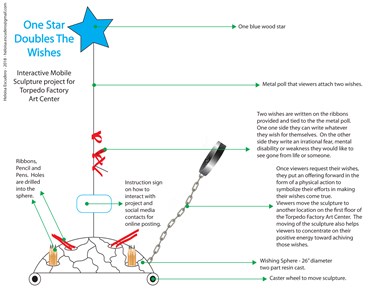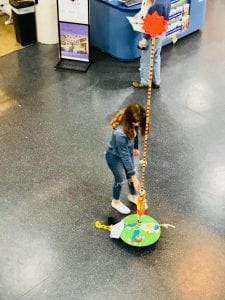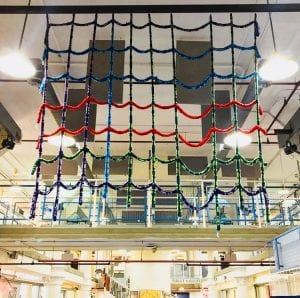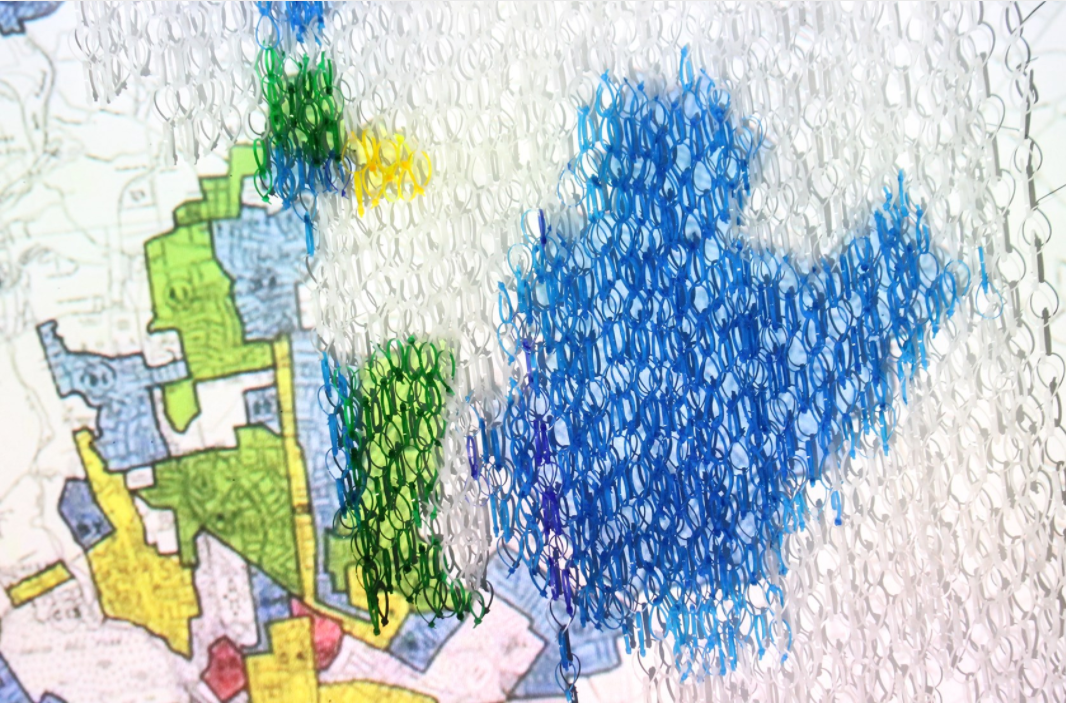The Torpedo Factory Art Center is happy to present the work of regional artists who were selected for “Art in Common Spaces” exhibition from April to September 2018. Through “Art in Common Spaces” the Art Center seeks to activate our public space to visitors with immersive public art. We will feature seasonal rotating exhibitions throughout the year to keep the artwork fresh and constantly evolving.
The juror for the Spring/Summer season was Lauren Ross, and independent curator based out of Richmond, VA.
Featured Artists for the Spring/Summer season:
Heloisa Escudero, Arlington VA
“One Star Double The Wishes”
2018
Wood, Ribbons, Pencil, Metal Poll, Resin Cast, Wheels
“One Star Double The Wishes” is an interactive sculpture takes that focus in the form of an action and gears the audience to think positively while requesting a wish for themselves and another for someone else out there who is mentally unstable. The moving of the sculpture helps viewers to concentrate on their positive energy. When viewers request their wishes they also put an offering forward in the form of a physical action to symbolize their efforts in making their wishes come true. Viewers are encouraged to move the sculpture to another location on the first floor of the Torpedo Factory Art Center to psychically manifest their wish.
Heloisa Escudero received her BFA in Photography and concentrations in Sculpture from the Massachusetts College of Art and MFA in Sculpture with concentration in New Genres at San Francisco Art Institute. She currently works at the Hirshhorn Museum as an Exhibition Specialist.
Kara Hammond, Fort Washington, MD
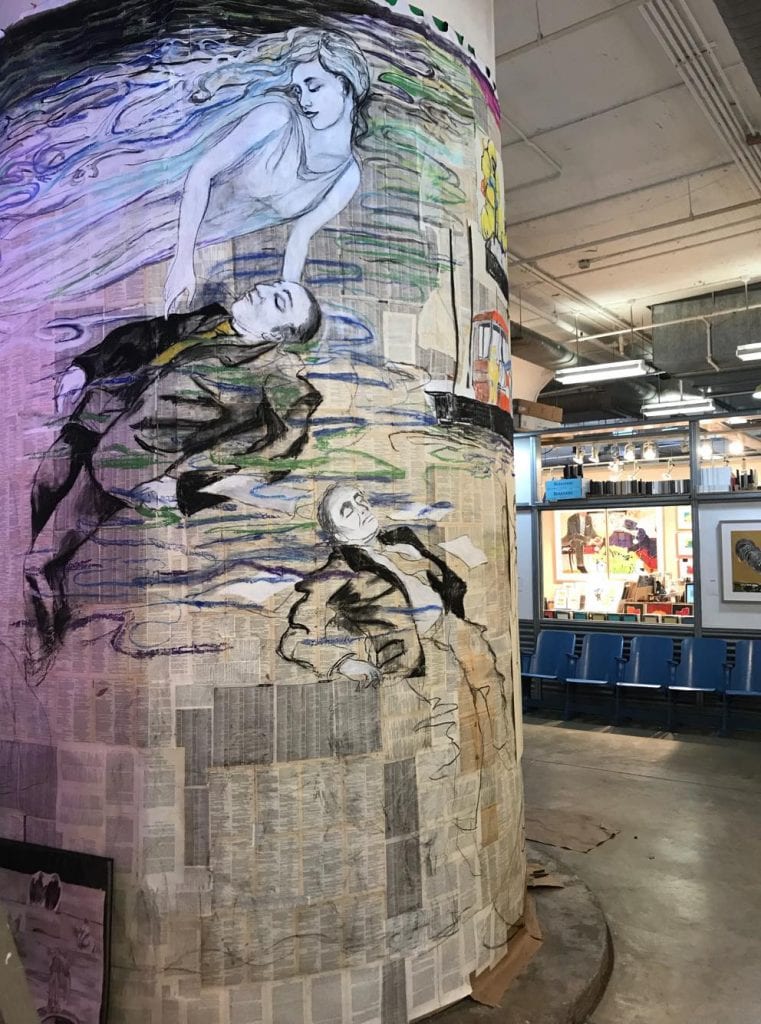
Kara Hammond, Dredging the Lethe, mixed media, 2018
(Torpedo Factory Artist: Studio 306)
“Dredging the Lethe”
2018
Pages of discarded textbooks, Collage, Gesso, Ink, Charcoal
Using the pages of discarded textbooks as a drawing surface, Hammond integrates, through collage, gesso, ink, and charcoal, a series of drawn images forming a mural, the central theme being the mythological River Lethe, a metaphor for cultural memory. The mural depicts historians who, upon discovering
a path to the Underworld of Greek Mythology, propose to dredge the waters of the River Lethe to mine the memories of all the dead who have passed there since the beginning of human time. The River Lethe is where Mnemosyne would submerge the dead as they pass to the underworld, so that they could forget their previous lives. Aided by the Muse of History, Clio, the historians take precautions to avoid the soporific nature of the waters, lest they become forgetful themselves. Mnemosyne, the Titan Goddess of Memory (and Clio’s mother), works to thwart the efforts of the historians, intending to let the past stay submerged. She also tends to a number of troubled souls who have inadvertently stumbled into the underworld, some of whom make heroic efforts to stay above the Lethe’s forgetful waters, to keep alive their stories, lest they be forgotten for eternity.
Kara Hammond received her BFA from East Carolina University and MFA at Tyler School of Art. She was juried in as a Torpedo Factory artist in 2014.
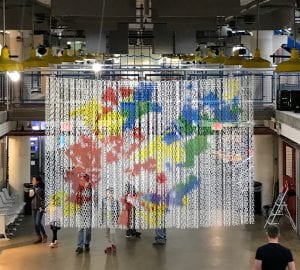
Kim Rice, Safety Net, 8,600 zip ties, 2018
Kim Rice, Baltimore, MD
“Safety Net”
2018
8,600 Zip Ties
“Safety Net” depicts the Richmond HOLC map made completely out of zip ties. In the 1930’s, the US Government made mortgages available through a program called the Home Owners’ Loan Corporation (HOLC). In a well-documented process known as redlining, government officials outlined neighborhoods on city maps and then color-coded the areas. The neighborhoods deemed “declining” (yellow) or “hazardous”(red)
were not considered for mortgages—these were the integrated or non-white neighborhoods. Banks and insurance companies followed the example of
the Federal Government and did not finance home ownership in these areas either. This practice was legal until 1968. The residue of this institutional racism continues to segregate, allowing some communities to thrive while others suffer. Equality in America is directly linked to property. It is the way we accrue money, pass down inheritance, and get access to education, food, and employment. Where you live in the United Statesis even linked to life expectancy.
Kim Rice is an artist based in Baltimore, MD. She received her BFA in Sculpture and MFA in Printmaking at the University of Oklahoma.
Amy Wike, Washington DC
“This is a Map”
2018
Fabric
“This Is a Map” incorporates both the history of the Torpedo Factory and that of Alexandria as a whole. The city’s street names are a distinct, uniquely identifiable aspect of Old Town Alexandria, and have earned a special place in the hearts of its community members. Employing Wike’s signature method of knitting language using Morse code as a basis for a pattern, the work consists of Alexandria’s beloved and historic street names knit into a map of the city’s original layout, showing the progression of its footprint through color. According to Wike’s research, Alexandria’s initial streets grew in four main waves.
”This Is a Map” is a playful and abstract way to experience these familiar roads and the city’s growth. Additionally, the incorporation of Morse code, a staple of maritime communication, recalls the Torpedo Factory’s original history with the U.S. Navy. Though the content is sourced from historical roots, this installation embodies the idea that each of our unique perspectives impacts that history, and everyone has a role in how our past is presented.
Amy Wike is an artist based in Washington, DC. She received her BA in Marketing and Entrepreneurship Management from the University of South Carolina.
For future art opportunities, please visit torpedofactory.org/artopps or subscribe to our mailing list.


